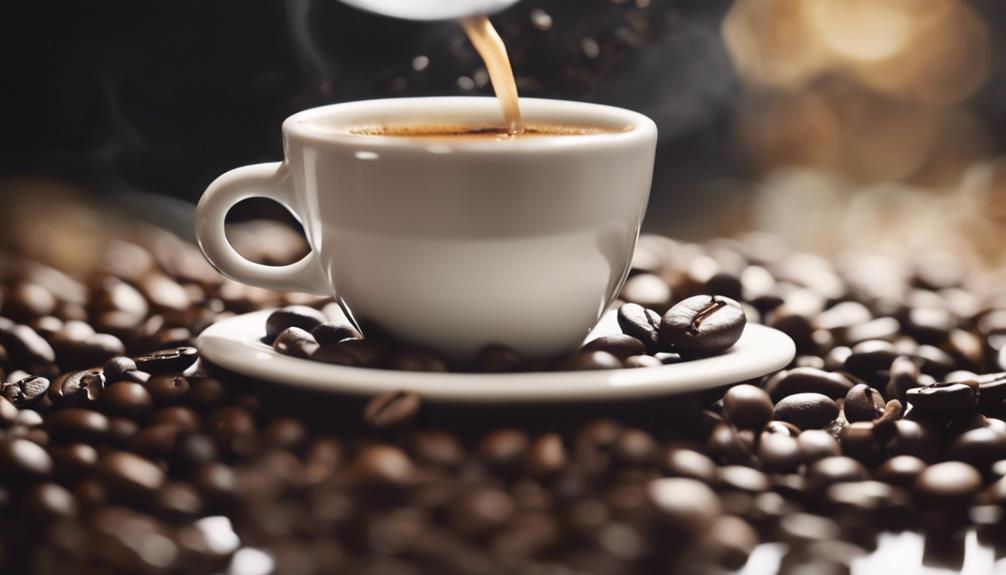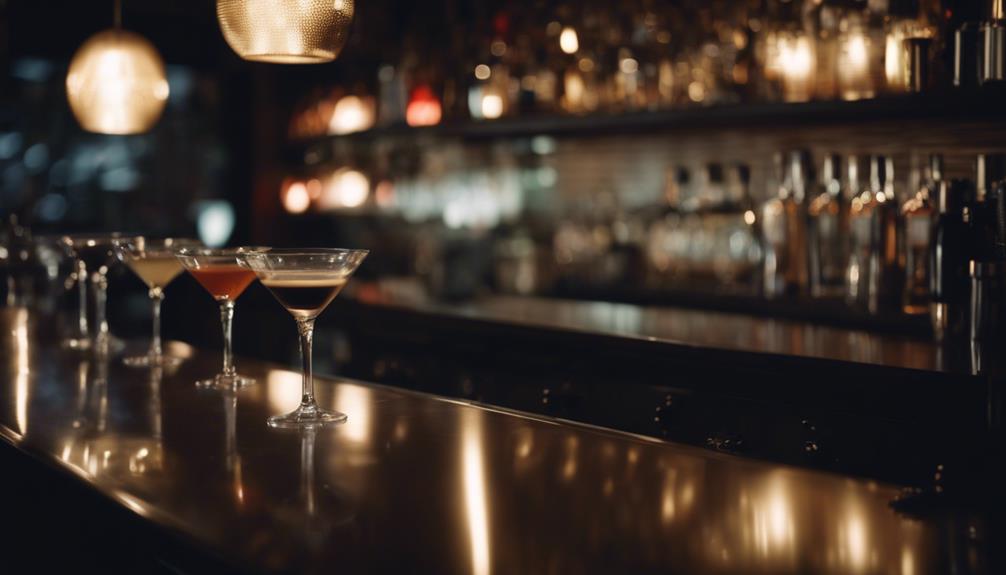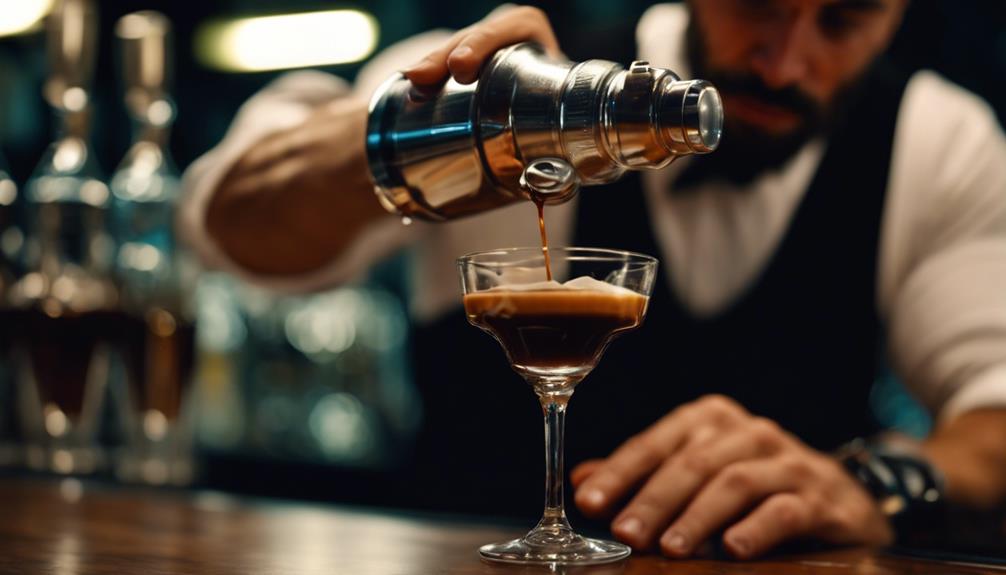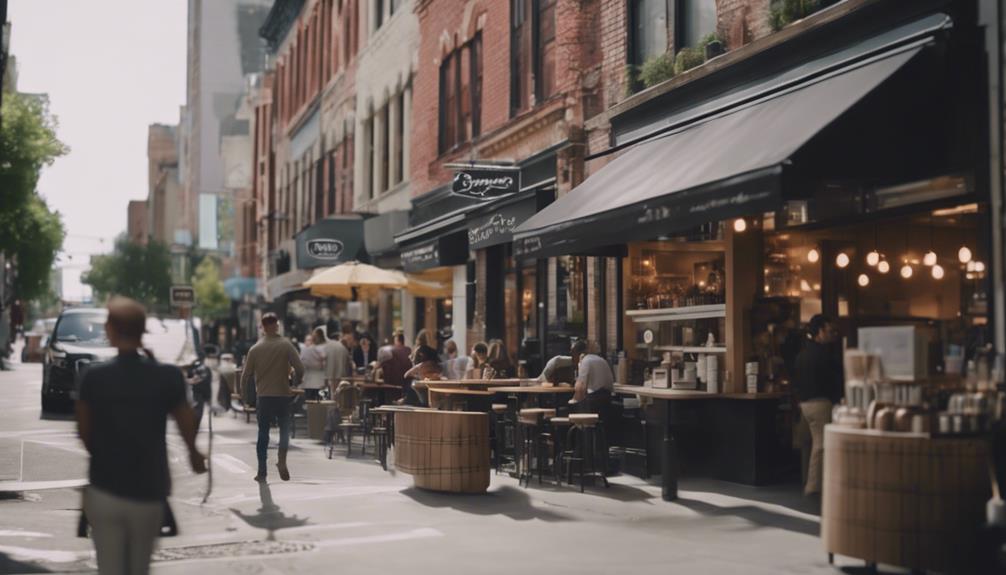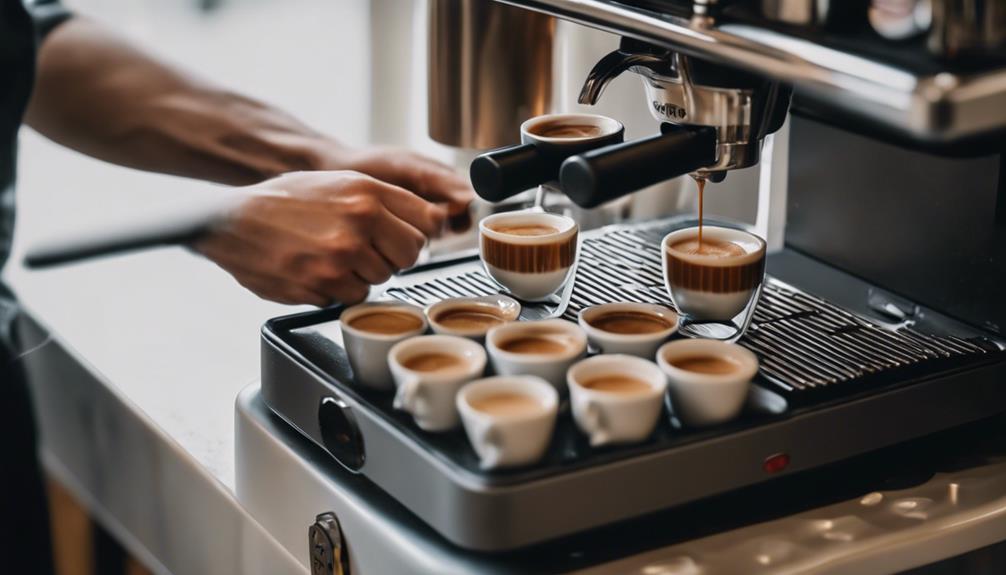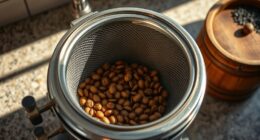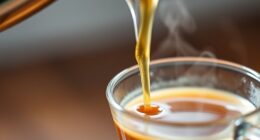You are on the brink of discovering the exact answer to the question that has been driving your curiosity: a standard 1-ounce shot of espresso typically contains approximately 63 milligrams of caffeine. This is significantly lower than an 8-ounce cup of brewed coffee, which typically contains around 95 milligrams. But what factors influence this amount? From the type of coffee bean to the level of roast and size of the grind, there are multiple factors that can affect the caffeine content. If you are curious about how this compares to your favorite espresso drinks or if there are additional benefits to moderate espresso consumption, the details are just a step away – and they may give you a whole new perspective on your daily shot.
Key Takeaways
- A standard single shot of espresso typically contains around 63 mg of caffeine in a 1-ounce serving.
- Starbucks single shot has about 75 mg of caffeine, while a double shot has 150 mg.
- Caffeine content in espresso can vary depending on factors like coffee bean type, roast level, grind size, and brewing method.
- Espresso has a higher caffeine concentration than brewed coffee, with approximately 63 mg per ounce compared to 12-16 mg per ounce.
Caffeine Content in Espresso
You'll get a significant caffeine boost from a single shot of espresso, which packs approximately 63 milligrams of caffeine into its 1-ounce serving. That's a substantial amount of caffeine, especially considering the small serving size.
In fact, espresso has more caffeine than brewed coffee, with a typical 8-ounce cup containing around 95 milligrams of caffeine. This is because the brewing methods used to make espresso result in a more concentrated beverage.
The type of coffee beans used can also affect the caffeine content in espresso, but the difference is relatively small. What's important to note is that a single shot of espresso provides a quick and potent caffeine kick.
If you're looking for an even bigger boost, a double shot, or doppio, contains around 126 milligrams of caffeine. Regardless of the amount, you can be sure that a shot of espresso will give you the energy lift you need to tackle your day.
Factors Affecting Caffeine Levels
While a single shot of espresso packs a considerable caffeine punch, the amount of caffeine you get can vary depending on several factors that influence the final product.
These factors include:
- The type of coffee bean used, with robusta beans containing about twice as much caffeine as arabica beans, affecting the caffeine content in coffee.
- The roast level, as lighter roasts often retain slightly more caffeine due to shorter roasting times.
- The grind size of the coffee beans, which should be fine for espresso, impacting the extraction efficiency and caffeine transfer during brewing.
- The brewing method and time, with espresso being brewed under pressure for about 25 to 30 seconds, allowing for a concentrated extraction of caffeine.
Keep in mind that these factors can greatly impact the amount of caffeine in your espresso, making it essential to understand what goes into your daily cup.
Espresso Vs Coffee: What's the Difference
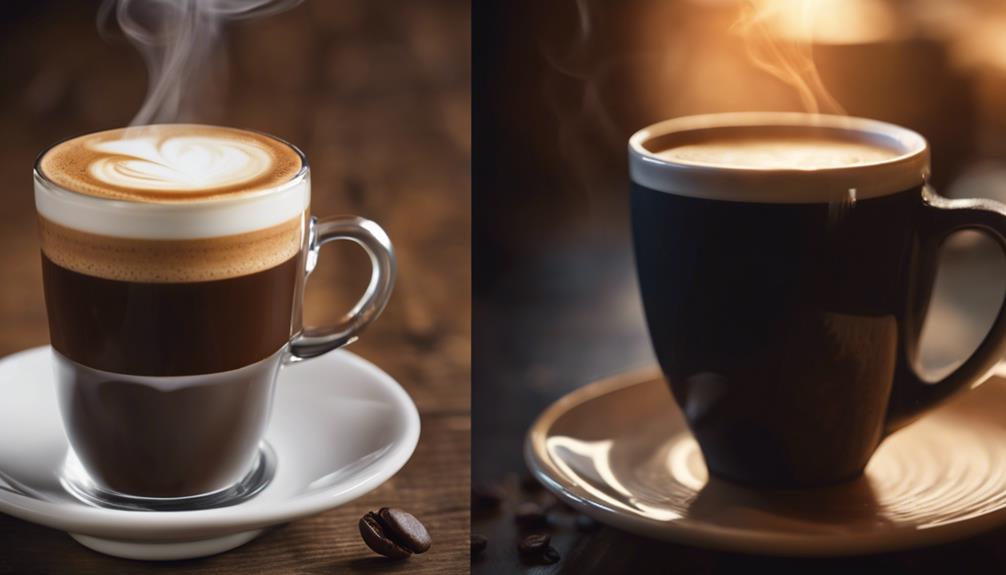
As you explore the world of espresso, you're probably wondering how it differs from your daily cup of coffee.
Let's start by examining the brewing methods that set espresso apart, like the high-pressure process that yields a unique flavor and caffeine kick.
Espresso Brewing Methods
Forcing hot water through finely-ground coffee under high pressure is what sets espresso brewing apart from other coffee-making methods. This unique process yields a concentrated shot, typically served in 1-ounce portions, with a richer flavor and thicker consistency than regular coffee.
But what makes espresso brewing so special?
Here are some key factors that contribute to the distinct taste and texture of espresso:
- Higher pressure: Espresso brewing involves forcing hot water through finely-ground coffee, resulting in a more concentrated shot.
- Shorter extraction time: The brewing method for espresso is faster than other coffee-making methods, which helps preserve the coffee's natural flavors.
- Finer grind: Espresso beans are ground finer than regular coffee beans, allowing for a more even extraction of flavors.
- Longer roast: Espresso beans are often roasted longer than regular coffee beans, giving them a deeper, more intense flavor.
Caffeine Content Comparison
You might be wondering how espresso and coffee stack up when it comes to caffeine content, and the answer might surprise you.
A standard 1-ounce shot of espresso packs a punch with approximately 63 mg of caffeine, making it a concentrated source of caffeine compared to brewed coffee. However, an 8-ounce cup of brewed coffee typically contains around 95 mg of caffeine, showing that while espresso has a higher caffeine concentration, the total caffeine content in a larger serving of coffee can exceed that of espresso.
When comparing caffeine content by volume, espresso takes the lead with roughly 63 mg of caffeine per ounce, while brewed coffee averages 12-16 mg of caffeine per ounce. Even a double shot of espresso (2 ounces) can contain about 126 mg of caffeine, comparable to the caffeine content found in larger servings of brewed coffee.
As a coffee lover, it's crucial to reflect on the brew methods, bean types, and serving sizes that affect caffeine levels in coffee. By understanding these factors, you'll be better equipped to make informed choices about your daily caffeine intake.
Caffeine in Popular Espresso Drinks
As you explore the world of espresso, you're probably curious about the caffeine content of your favorite drinks.
You might be wondering how much caffeine is in a cappuccino or latte, or what the difference is between a small and large serving at your local coffeehouse.
Let's take a closer look at the caffeine content in popular espresso drinks to get a better understanding of what you're getting in your cup.
Espresso Drink Caffeine Content
In a typical espresso-based drink, the amount of caffeine can vary considerably depending on the type and size of the beverage, with some popular options containing up to three shots of espresso. As you navigate the menu, it's crucial to know what you're getting.
Here's a breakdown of the caffeine content in popular espresso drinks:
- A medium serving of cappuccinos and lattes typically contains 2-3 shots of espresso, resulting in around 173 mg of caffeine.
- At Starbucks, a single shot of espresso contains about 75 mg of caffeine, and a double shot has 150 mg.
- Mocha drinks can pack a punch, with 90 mg for a short size and 180 mg for a venti size due to the added chocolate.
- Americanos made with espresso can range from 75 mg for a short size to 300 mg for a venti size, depending on the number of shots used.
Caffeine in Coffeehouse Drinks
From mochas to Americanos, the caffeine content of popular espresso drinks can vary greatly, with some packing a surprising punch. As you drink coffee, you might wonder how much caffeine you're actually getting. A typical cup of coffee contains around 95-200 mg of caffeine, but espresso-based drinks can be quite different.
When you order a cappuccino or latte, you're usually getting 2-3 shots of espresso, resulting in caffeine levels around 173 mg for a medium serving. At Starbucks, a tall latte or cappuccino with one shot has about 75 mg of caffeine, while a grande version with two shots contains about 150 mg.
Mocha drinks can vary greatly in caffeine content, having around 90 mg for a short/tall and up to 180 mg for a venti due to the addition of chocolate. Americanos can range from 75 mg of caffeine for a short size to 300 mg for a venti, depending on the number of espresso shots used.
Health Benefits and Nutritional Value
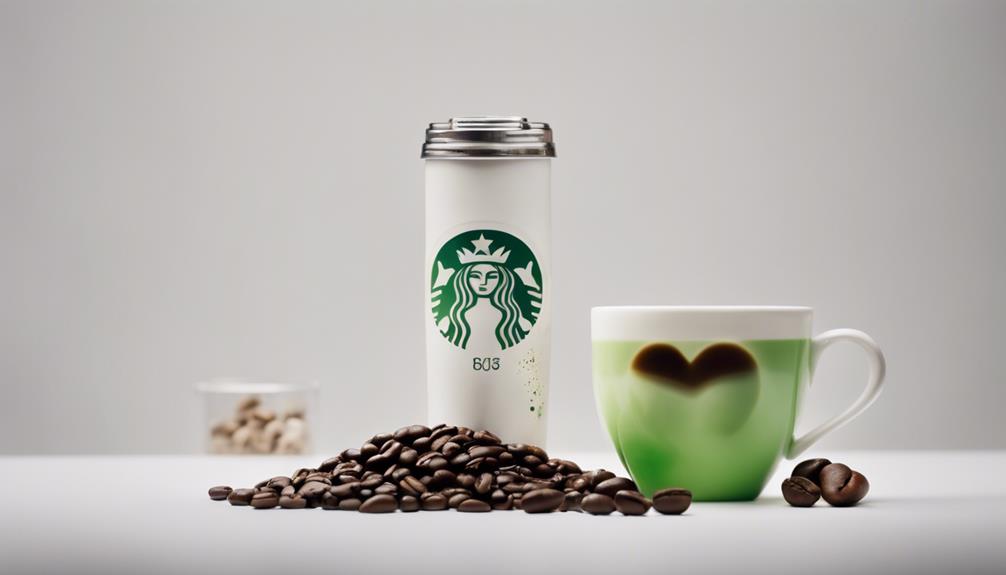
You'll reap several health benefits when you drink espresso in moderation, including improved cognitive function and alertness thanks to its caffeine content. But that's not all – espresso also packs a nutritional punch. It's a rich source of B vitamins and potassium, essential for maintaining overall health.
Here are just a few more reasons to enjoy your daily espresso:
- Boosts brain health: Regular consumption may reduce the risk of Parkinson's and Alzheimer's diseases.
- Fights inflammation: Antioxidants in espresso help reduce inflammation in the body, which can lead to chronic diseases.
- Enhances physical performance: The caffeine kick can increase adrenaline levels, making espresso a popular choice among athletes.
- Supports heart health: Moderate espresso consumption may lower the risk of heart disease and stroke.
Coffee Consumption Trends and Facts
Around 70% of Americans, including yourself, make coffee a weekly habit, with a significant 62% relying on their daily cup to get started. You're part of a large group that can't imagine starting the day without a cup of joe.
Coffee consumption trends show that younger drinkers, aged 18-24, often enjoy their coffee with breakfast, while older drinkers tend to do so at a higher rate – around 90%.
When it comes to espresso consumption, habits vary greatly by region, which affects how people perceive the caffeine kick. The Department of Agriculture reports that the average caffeine content in a shot of espresso is approximately 63 mg, while an 8-ounce cup of coffee contains around 95 mg.
Factors that affect your coffee intake, such as age and regional habits, play a significant role in determining your caffeine content. Understanding these trends and facts can help you make informed decisions about your coffee consumption and better appreciate the caffeine boost you get from your daily cup.
Debunking Caffeine Myths and Misconceptions
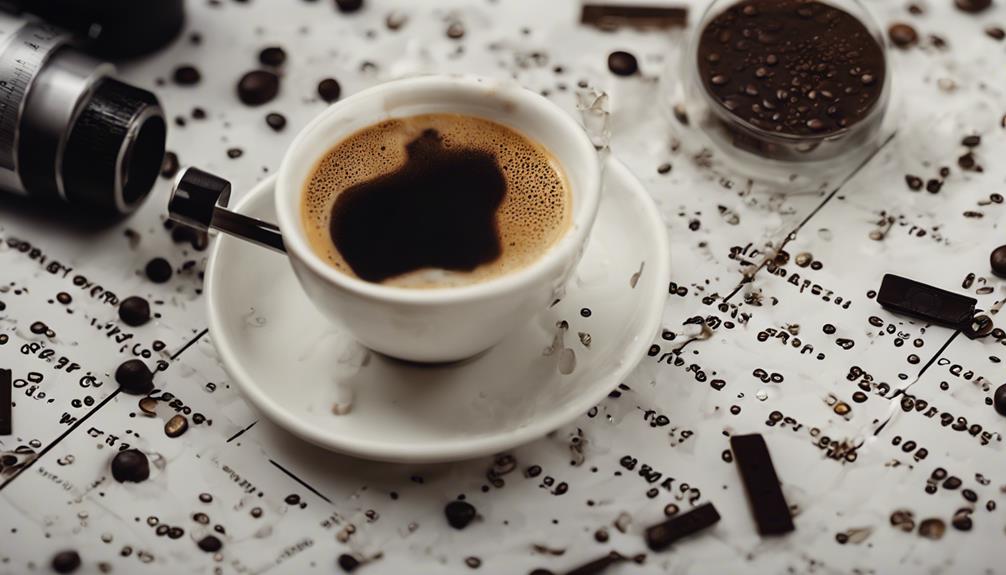
When it comes to caffeine, misinformation abounds, and separating fact from fiction can be a challenge, especially in the domain of espresso. You've probably heard some myths about espresso, but it's time to set the record straight.
Here are some common misconceptions about espresso and caffeine:
- You think espresso has less caffeine than brewed coffee, but it actually has a higher concentration of caffeine per ounce.
- You assume a smaller serving size of espresso means less caffeine, but the total amount can vary greatly depending on the serving size.
- You believe all espresso drinks, like lattes or cappuccinos, have the same amount of caffeine, but it really depends on the number of shots used.
- You're convinced that decaffeinated espresso has zero caffeine, but it actually still contains about 0.3 mg per shot.
Now that you know the truth, you can make informed decisions about your caffeine intake. Remember, it's all about the concentration and serving size, not just the type of coffee.
Frequently Asked Questions
How Much Caffeine Is in a Single Shot of Espresso?
You're wondering how much caffeine is in a single shot of espresso? Well, you'll find around 63 milligrams in a typical 1-ounce serving, but this amount can vary slightly depending on the type of coffee beans used.
Is 2 Shots of Espresso a Lot of Caffeine?
Coincidentally, you're wondering if two shots of espresso are a lot of caffeine, and the answer is, it's a significant amount, but still within the safe daily limit for most adults, unless you're particularly sensitive to its effects.
How Much Caffeine Is in 1 Shot of Starbucks Espresso?
You're wondering how much caffeine is in 1 shot of Starbucks espresso. Well, you'll be getting around 75mg of caffeine, which is a bit higher than the average shot from other sources, thanks to Starbucks' unique blend and brewing technique.
Which Has More Caffeine, Espresso or Regular Coffee?
You might be surprised to know that an 8-ounce cup of brewed coffee typically contains more caffeine than a 1-ounce shot of espresso. However, espresso packs more caffeine per ounce, making it a more concentrated pick-me-up.
What is the caffeine content in a shot of espresso?
A shot of espresso typically contains around 63 milligrams of caffeine content in espresso, which is higher compared to a standard cup of coffee. This concentrated amount of caffeine is why some coffee lovers prefer espresso for a quick energy boost.
Conclusion
You've made it to the end of this caffeine-packed journey, but the real question is: are you ready for the ultimate buzzkill?
Everything you thought you knew about espresso might be turned upside down.
Stay tuned for the next installment, where we'll dive deeper into the world of caffeine and uncover the secrets that'll leave you questioning your daily cup.
The truth is out there, but are you prepared to handle it?
